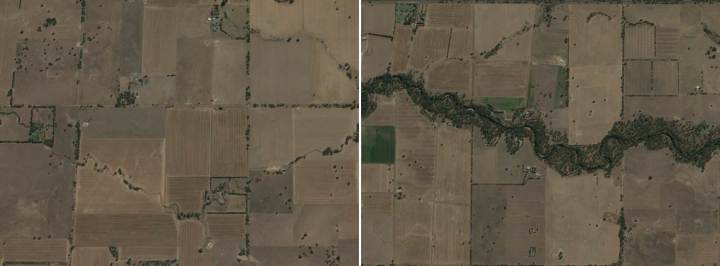In this post Dale Nimmo, Angie Haslem and Andrew Bennett discuss their recent paper ‘Riparian tree cover enhances the resistance and stability of woodland bird communities during an extreme climatic event’
You can also watch a slide cast about this research and related papers, in the form of an Australian bush poem.
Something alarming happened in the woodlands of southern Australia last decade. The birds stopped calling. Well, not entirely, but substantially. The chorus of kookaburras, honeyeaters and babblers that usually make the woodland air burst with song was reduced to a whisper.
And we think we know why. The region was gripped by a record-breaking drought, known now as the ‘Millennium Drought’, which spanned nearly a decade from 2001–2009. The drought crippled the region’s biodiversity: frog populations crashed, and over half of terrestrial bird species declined.

When the drought broke spectacularly in 2010 with flooding rains, there was a sense of cautious optimism that the region’s biodiversity might have been offered a reprieve. However, two years after the drought had broken, that optimism turned again to alarm. Monitoring data revealed that although around one quarter of bird species increased following the floods, most species had not recovered. Further still, 14–29% of species (depending on the dataset) continued to decline, despite the drought ending. Promisingly, in our recent paper in Journal of Applied Ecology, we think we have found a hint of a silver lining.
If you read the climate change literature, you may be familiar with the idea of ‘climate refugia’. This concept suggests that some areas are buffered from the impacts of climate change or climatic extremes such as drought. For instance, areas that have relatively high moisture or stable microclimates may offer refuge for species during drought. It follows that these areas should be targeted for protection for conservation, to enhance the capacity of biodiversity to persist during climate change.
The concept provides a sense of agency among conservationists in the face of a looming global disturbance over which we have little control. However, although there is evidence of refugia operating over evolutionary time scales and at continental spatial scales, the evidence that we can create refugia at the scale of conservation management is much scarcer.
Our paper provides that evidence. We found that landscapes with more tree cover on productive soils – such as on riverbanks, stream sides, drainage lines and floodplains, collectively termed ‘riparian vegetation’ – retained a higher proportion of their bird species during the drought.

This means that past land clearing, for agriculture and other human land uses, is likely to have diminished the capacity of bird communities to resist the impacts of drought. This might explain why the drought had such huge effects on the region’s bird fauna. On the other hand, by protecting riparian vegetation, and by revegetating cleared riversides, floodplains and drainage lines, we could enhance the capacity of bird communities to persist during the next big drought. That is, we could build climate refuges.
Although this sounds promising, our results come with an important caveat. When the drought broke, landscapes with less riparian tree cover tended to ‘bounce back’ to a greater extent. That is they were more ‘resilient’. This is largely because these same landscapes had a greater need for recovery, having lost a greater proportion of their species pool during the drought. By contrast, landscapes with more riparian tree cover lost fewer species and so had less of a need for recovery post-drought. Over the duration of the entire drought–flood cycle, these two opposing trends cancelled each other out such that two years after the drought, a similar fraction of the bird community was lost across all landscapes.
What does this mean? In simple terms, riparian vegetation enhances the ability of landscapes to retain bird species during the drought, but does not arrest longer-term declines that may cause ongoing species loss over successive drought events.
This does not diminish the important role of riparian vegetation for bird conservation during drought. Retaining a larger portion of the species pool throughout the landscape means that ecological functions continue, functions critical to ecological and economic systems, such as pollination and insect control.

We also know from previous work in these same landscapes that increasing tree cover of any kind increases the richness of woodland birds. Indeed, the total amount of tree cover in the landscape is the most important influence on the number of woodland bird species that can occur. Adding riparian tree cover to heavily modified landscapes gives huge ‘bang for your buck’ in terms of bird conservation, as productive areas support more species and provide specialised habitat for species that favour riparian vegetation. Finally, other work has revealed that landscapes with more tree cover had more stable bird communities, measured in terms of species turnover, over the duration of the drought.
Combined, these results suggest that maintaining and revegetating riparian areas will provide many benefits to bird conservation. It also has many other benefits, including protecting water quality, enhancing aquatic environments, and creating a visually attractive environment. It’s a ‘win-win’ for sustainable land management and nature conservation.
Reblogged this on Landscape Ecology Research Group.
LikeLike
A great story on why our biodiversity has declined and what we can do to help! A word of warning however. Please, please plant at a density that mimics the natural community that has been cleared. In most cases in the cooler parts of Australia, this will have been open grassy woodland, with shrubby patches here and there. Secondly, please use wattles in the plantings. And most importantly, if the area is a natural grassland, please respect that too. A few trees and patches of shrubs are OK in a grassland, but I have seen too many lovely grasslands destroyed in the guise of “revegetation”. Rainer Rehwinkel, grassy ecosystem ecologist
LikeLike